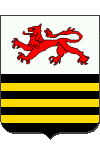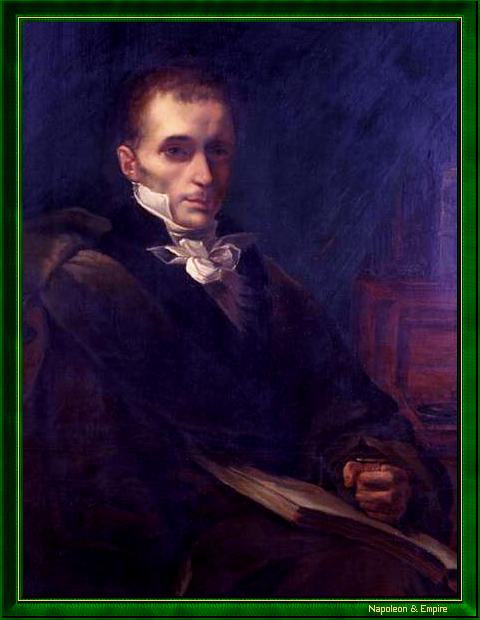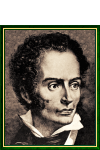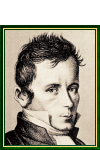René-Theophile-Hyacinthe Laennec
Pronunciation:

René-Théophile-Hyacinthe Laennec was born into a family of lawyers in Quimper, Brittany, on February 17, 1781.
At the age of five, orphaned by his mother's death from tuberculosis, his father entrusted him to the care of an uncle, a professor of medicine and rector of the University of Nantes.
Young René followed his uncle's example and began studying medicine in Nantes. In September 1795, he was appointed assistant surgeon 3rd class, and in 1797 was sent to the military hospital in Brest, with the rank of surgeon 3rd class. The following year, he won a competitive examination to become a second-class medical officer, enabling him to continue his studies in Paris.
In 1800, he became a pupil of Jean-Nicolas Corvisart at the Hôpital de la Charité, then of Guillaume Dupuytren. He received his doctorate in medicine on June 11, 18041804, after defending his thesis entitled Proposition sur la doctrine d'Hippocrate relativement à la médecine pratique, in which he emphasized the importance of semiology and nosology in the treatment of disease.
During the Empire, he practiced pathological anatomy with Gaspard Laurent Bayle, studying pathologies such as cirrhosis of the liver on the basis of lesions observed at autopsy. At the same time, he ran a private practice and devoted himself to his clientele at no. 5 rue du Jardinet.
In 1808, he was appointed physician to Cardinal Fesch. He also occasionally treated François-René de Chateaubriand, Félicité de Lamennais, Abbé Emery, Cardinals Ruffo, Visconti and Eskin, and Madame de Staël. This devout Catholic also practiced daily charity towards the needy, whom he consulted and vaccinated free of charge at the dispensary of the Société philanthropique on rue Copeau (now rue Lacépède).
In 1814, after the Emperor's first abdication, René Laennec provided care at the Salpêtrière hospital for young Breton soldiers suffering from typhus, whose language no one understood.
It was at the start of the Restoration that Laennec invented the instrument that would make him famous for ‒ at least - the next two centuries. In 1816, having just been appointed to the Hôpital Necker, he turned his attention to lung diseases, examining patients using the percussion technique described as early as 1761 by the Austrian Leopold Auenbrugger and disseminated in France by Corvisart. It was then that he created the stethoscope, initially a simple roll of tied paper called a pectoriloque, which he soon perfected, founding a new practice, auscultation.
This technique made it possible to perceive internal body sounds, analyze them and relate them to anatomical lesions, which would prove essential for diagnosing respiratory diseases - including the dreaded tuberculosis - and cardiovascular diseases.
In February 1818, René Laennec presented his discoveries in a speech to the Académie de Médecine, and in August of the same year, he published his Traité d'auscultation médiate (Treatise on medial auscultation), in which he classified the noises emitted in the thorax, taking pulmonary semiology by leaps and bounds. In 1822, he was appointed Professor of Practical Medicine at the Collège de France.
His other contributions to medicine include descriptions of peritonitis and cirrhosis, pulmonary metastases of melanoma, numerous contributions to knowledge of tuberculosis, asthma, cirrhosis of the liver and spontaneous mediastinal emphysema, and the discovery of prenatal thrombosis...
However, suffering from tuberculosis himself, he left Paris in April 1826 and retired to his manor house in Kerlouarnec, Douarnenez-Ploaré, which he inherited from his mother. He died there on August 13, 1826, aged just 45, and is buried in the Ploaré cemetery.
"René-Theophile-Hyacinthe Laennec". French school of the nineteenth century.

One of Lyon's four medical faculties bears his name, as do several hospitals.
In 1952, the French Postal Service released a 12.00 Franc stamp bearing the image of René Laennec .
In his rare spare time, René Laennec also tried his hand at painting, as evidenced by this painting signed with his name.
Address
17, Rue de l'Abbé Grégoire. Paris 6ème arrondissement
This is where René Laennec lived in 1825-1826.Remerciements
The photo of the painting signed René Laennec was kindly provided to us by the current owner of the work, Doctor Jean-Charles LACHAMP.Other portraits

"René Laennec". Print of the nineteenth century.

"René Laennec". Print of the nineteenth century.